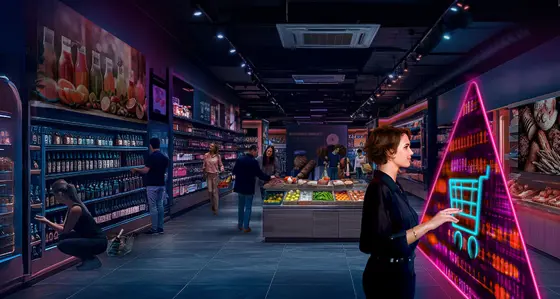
The AI advantage: Reshaping retail supply chains for a new era
7 min read 12 November 2025
The supply chain landscape has shifted. What began as pandemic-driven disruption has evolved into an era of persistent volatility, marked by wave after wave of geopolitical tensions, trade disputes, and economic realignments.
As organizations navigate this new normal, many consumer brands have already started reshaping their supply chain operations. Our previous article explored how industry leaders are reinventing product, packaging, and sourcing strategies in response to tariff-driven disruption.
While essential, this reinvention is only the first step in a much larger transformation journey. The companies that will thrive in this new paradigm are those that go beyond reactive adjustments to build truly adaptive supply chain capabilities. They recognize that in a world where disruption is the only constant, traditional supply chain management, no matter how well-executed, is not enough.
This is where artificial intelligence (AI) becomes transformational. AI offers consumer goods and retail companies the opportunity to create a step change in agility, efficiency, and resilience. Rather than simply responding to disruption, AI-powered supply chains can anticipate, adapt to, and ultimately capitalize on market volatility.
In this article, we examine practical examples of how consumer products and retail companies can strategically integrate AI across their supply chain operations, as well as the capabilities they should prioritize to shape future-ready supply chains.
Sharper demand forecasting and planning
AI and machine learning (ML) models have clear advantages over traditional spreadsheet-based forecasting and planning methods. They can analyze historical sales, market trends, promotions, and external data, including weather, macroeconomics, and social sentiment, to predict demand more accurately.
Crucially, AI algorithms are capable of continuously incorporating new and diverse data, and mining it to uncover fresh insights, faster. Unlike traditional approaches that require manual updating of data and forecasting adjustments, AI models can work with real-time data and detect changes in demand patterns almost instantly. As AI often anticipates demand changes, rather than simply responding to them, it enables much more rapid, agile decision-making.
| Amazon uses ML-driven demand forecasting to maintain optimal warehouse stock levels and react flexibly to spikes or dips in product demand. It achieves this across over 400 million products with minimal human input. |
Optimized inventory management
Today’s supply chains are extraordinarily intricate networks, where inventory flows through multiple tiers, from raw material suppliers and manufacturers to distribution centers, warehouses, and retail locations. AI makes it possible for organizations to optimize inventory holistically across this entire chain, dynamically balancing stock levels, replenishment quantities and timing, refining allocation priorities during shortages, and supporting safety stock adjustments in response to demand volatility.
When coupled with computer vision, AI also helps optimize warehouse inventory management. Automated inventory counting eliminates time-consuming, labor-intensive stock checks and cycle counts, making it easier for companies to stay on top of inventory levels.
| Netherlands-based logistics provider GXO pioneered the use of AI-powered inventory counting in one of its warehouses. Its system can automatically scan up to 10,000 pallets per hour, rapidly producing a highly accurate picture of stock levels to support better inventory control and space optimization. |
Smoother routes for logistics and transportation
Generative AI (GenAI) significantly reduces the lead time for producing logistics documentation. This includes auto-generating and consolidating shipping documents, spotting errors and making corrections. Likewise, dynamic load optimization improves container and truck utilization, boosting efficiency and reducing the environmental impact of shipping.
Once deliveries hit the road, AI-driven route optimization reduces fuel, time, and costs by considering real-time traffic, weather, and delivery constraints. Meanwhile, predictive fleet maintenance, powered by a combination of IoT and AI technologies, allows firms to schedule maintenance more effectively and detect issues before they cause breakdowns, maximizing uptime while minimizing costs.
| Walmart has developed a proprietary AI logistics solution called Route Optimization, which optimizes driving routes in real time, maximizes packing space, and minimizes miles travelled. The solution has helped the retail giant to eliminate 30 million driver miles from its routes, saving 94 million pounds of CO2 in the process. |
Fine-tuning procurement and supplier management
By rapidly analyzing large volumes of publicly available information, including supplier performance data, market trends, and geopolitical risk indicators, AI significantly accelerates market analysis and supplier identification. This speed is critical in helping consumer brands make timely and informed procurement decisions.
Intelligent sourcing platforms are beginning to automate complex procurement decisions themselves. These systems analyze historical contract performance, market conditions, and supplier capabilities to recommend optimal sourcing strategies and even conduct preliminary negotiations using AI-powered chatbots.
| Unilever is using AI to simplify and speed up supplier discovery. With a third-party application that provides extensive data and insights on global suppliers, the multinational company can identify and vet potential supply chain partners quickly, consistently, and comprehensively. |
Elevating customer service
Ultimately, supply chain excellence is measured by customer experience. This is where AI can create some of the most visible competitive differentiation. Intelligent chatbots provide customers with instant responses to routine enquiries, proactively addressing concerns before they escalate. End-to-end visibility platforms powered by AI synthesize data from warehouses, logistics providers, and last-mile carriers to offer real-time updates on shipment status and potential delays. This allows retailers to share more accurate delivery estimates and keep customers informed about order progress.
| Best Buy launched a genAI virtual assistant that allows customers to access self-service support online, in app, and via the contact center. Using the assistant, customers can quickly troubleshoot product issues, make changes to their order delivery, and even manage their subscriptions and memberships. |
Two essential dimensions of AI enablement
While AI offers immense promise, realizing its full value requires organizations to master two critical dimensions that separate leaders from followers – innovation and adaptability. We’ve distilled these capabilities into a quadrant of AI enablement:
| High innovation | Low innovation | |
| High adaptability |
Leaders These brands are going beyond conventional AI use cases while integrating and scaling technology seamlessly across supply chain processes and broader organization. |
Hedgers Incorporating AI across suplly chain and organization but haven't innovated specific use cases, processes or products significantly.
|
| Low adaptability |
Innovators at risk Brands willing to be more experimiental with AI adoption, but remain confined to pilots and have limited execution to broader supply chain and organization. |
Laggards Brands remaining behind in adoption of AI and lacking in innovation. Must vunerable to disruption.
|
Innovation leaders are willing to experiment beyond established use cases, encouraging teams to explore unconventional applications and challenge traditional assumptions about how supply chain processes should function. This means moving past safe, incremental improvements to pursue breakthrough opportunities that can fundamentally reshape competitive positioning.
Equally important to the success of AI adoption is adaptability. Rather than forcing standardized platforms to fit unique business contexts, the most successful organizations right-size and right-scope their AI investments. This tailored approach transforms AI from a disruptive overlay into an organic extension of organizational capabilities, maximizing both adoption success and long-term value creation.
These capabilities can’t simply be tacked on to existing supply chain setups. They must be built in from the ground up, and considered at every stage of supply chain design and operation.
Getting started with AI in your supply chain doesn’t have to be daunting. Begin with a few focused steps that create real impact:
- Scan the horizon to identify the most relevant AI use cases for your industry and supply chain.
- Build a use case library across Plan–Source–Make–Deliver to uncover where AI can drive the most value.
- Prioritize strategically to focus on the use cases that align with your business goals.
- Test and learn rapidly through proof-of-concept pilots to demonstrate tangible results.
- Foster a culture of AI adoption to ensure lasting success and scalability.
At Baringa, we’ve helped hundreds of consumer products and retail clients start — and scale — their AI journey, building the supply chains of the future. To explore how we can help you sharpen your operations, connect with our team.
Our Experts




Related Insights

AI - its role in revolutionizing the food and beverage industry
Join Baringa's Evan Kelly and trailblazing entrepreneur, best selling author, digital transformation guru, and AI thought leader Charlene Li as they explore how AI is revolutionizing the food and beverage industry.
Read more
From instinct to intelligence: why the future of food and beverage demand planning is AI-driven
Discover how AI enables smarter, real-time demand planning in F&B, boosting accuracy, agility and profitability in a fast-changing market.
Read more
Shaping food and beverage innovation with AI
AI is reshaping food and beverage. Move fast, transform boldly, and turn innovation into growth before your competitors do.
Read more
How can food and beverage companies transform their thinking about GenAI – from a tool at the fringes to the foundation for growth?
Explore how food and beverage companies can unlock GenAI’s full value by transforming strategy, operations and mindset for sustained growth.
Read moreIs digital and AI delivering what your business needs?
Digital and AI can solve your toughest challenges and elevate your business performance. But success isn’t always straightforward. Where can you unlock opportunity? And what does it take to set the foundation for lasting success?